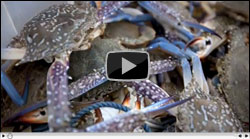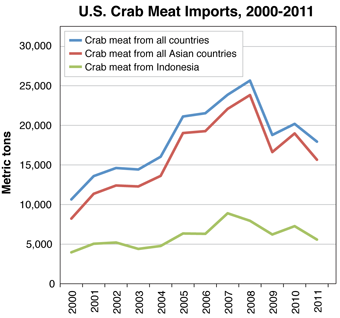|
Online Feature
Old Story, New Setting:
The Sustainability of Asian Crab
Jeffrey Brainard
Distribution: Throughout the Indian and western Pacific oceans: Japan, the Philippines, Southeast and East Asia, Indonesia, eastern Australia, Fiji, and westward to the Red Sea and East Africa.
Key distinguishing markings: Males have brilliant blue-colored markings; females are olive green. Like the Atlantic blue crab, they have a set of paddle-shaped swimming legs.
Size: Adults up to 20 centimeters, or 7.9 inches (carapace).
Source: United Nations Food and Agriculture Organization
IT'S A FAMILIAR STORY for people who harvest seafood. A fishery prospers over time but becomes jeopardized in part by its own commercial success. As stocks dwindle, harvests decline, and industry and government officials try to protect the resources that remain.
It happened in Maryland in the Chesapeake Bay, where harvests of blue crabs declined in the 1990s and 2000s because of fishing and environmental causes, scientists say. And it appears to be happening again halfway around the world. This time it's in Asian countries that began exporting crab meat some 20 years ago. This industry now supplies the majority of the crab meat consumed in the United States. The rapid growth of harvests to provide those exports is blamed for signs of possible overfishing that have appeared in places like Indonesia and the Philippines. The number and size of Asian crabs caught have dipped.
Imported crab meat continues to be a sensitive topic around the Chesapeake region. During the past two decades, American companies, led by Maryland-based Phillips Foods Inc., have increasingly imported meat from Asia. They wanted to satisfy a growing demand for crab cakes in America and provide a product available year-round. But that influx of imported meat was soon blamed for the decline of the Bay's fishing industry and the number of working watermen. The import industry counters that the supply of crab from the Chesapeake Bay and other states remains far below the level needed to meet demand from American consumers.
These import companies have recently begun to pay attention to the growing signs of fishing pressure in Asia. Not only do they want to assure a steady supply of crab meat to maintain their businesses; they also know that consumers want sustainable seafood. To satisfy this demand, Walmart and other retailers now require that their crab meat be sold with a stamp of approval from an organization like the Marine Stewardship Council, a worldwide network that vets fisheries to assure that they are environmentally sustainable. Asian crab meat doesn't yet meet that standard, but Phillips and other corporations hope to achieve it.
Clues About Unsustainability
The preliminary warning signs from Asia are mostly anecdotal but troubling. The average size of crabs caught has declined, suggesting that fewer crabs were surviving to adulthood and reproductive age. Fishermen in one part of Indonesia were catching 5 crabs per kilogram in 2000; four years later, their catch averaged 10 crabs per kilogram, according to the Sustainable Fisheries Partnership, a nonprofit group.
"When you see a species that's getting smaller, it means in my opinion that it's experiencing some stress," said Steve Phillips, chief executive officer of Phillips Foods Inc., in a YouTube video posted in 2011. "We took the lead initially on sustainability issues because of my experience as a young child growing up on the Chesapeake Bay and seeing what can happen to a resource if it's not properly managed."

Phillips Foods CEO talks about crab sustainability and seafood sustainability efforts in the company. View video . . .
It's too early to judge with confidence whether current harvest levels in Indonesia and other Asian countries are sustainable, says Ed Rhodes, director of sustainability for Phillips. That's because nations like Indonesia and the Philippines, two of the largest exporters of blue swimming crab meat to the U.S., have lacked the scientific expertise to do detailed studies of the stock there.
"We don't have NOAA or state government that spends any money on the resources [in Asia]," says Rhodes, formerly a shellfish researcher with NOAA, the National Oceanic and Atmospheric Administration. "Things like stock assessments are not done. When we went into these countries, as we started our sustainability programs six years ago, none of those things existed. So we, the industry, had to pay for it."
Phillips and 15 other American companies are funding a group, the National Fisheries Institute Crab Council, formed in 2009 to better understand the current status and future direction of the Asian crab population. The council, of which Rhodes is chairman, helped to establish local producers associations in Indonesia, the Philippines, and other crab-exporting countries. The group is also financing research to get more information on the size of the blue crab population. Council representatives are encouraging local fishermen in Indonesia to use environmentally friendly fishing gear, like crab pots, instead of nets dragged on the bottom.
To fund the work, the council's member companies have agreed to pay 1.5 cents for every pound of crab meet imported into the United States. That raised about $1-million in 2011. The World Bank has also supported the council's efforts, awarding it grants of $50,000 a year for three years.
Toward Better Management

Source: National Marine Fisheries Service
Understanding the Asian crab population is one challenge; another is managing the fishery once better knowledge is acquired. Indonesia and other Asian countries lack a system of fisheries rules and enforcement on par with those in the United States. The Philippines may become one of the first Asian countries with such rules later this year, when it is expected to release its first-ever national policy framework for managing the blue swimming crab.
Much of the Crab Council's work has depended on voluntary efforts by Asian seafood companies and fishermen, Rhodes said. To guide those efforts, the U.S.-based Crab Council in 2011 exerted its influence as a purchaser of crab meat by giving suppliers a size limit for blue swimming crabs: crabs must be 8 centimeters (about 3 inches) or larger in carapace width. That's to ensure that enough juvenile crabs survive to spawning age. But it's up to managers at locally owned processing plants to police themselves.
The Crab Council and its partners have made a good start and are working hard, says Michael Abbey, an official at NOAA who specializes in international fisheries. "I don't think you could ask for a better group of dedicated business professionals," he says. "Everybody understands what the end goal is, and everyone understands it's going to take a few years to get there."
But does it matter to Maryland if crab meat harvested from Asia or other countries outside the United States becomes environmentally unsustainable? After all, wouldn't a decrease in that supply in fact benefit Chesapeake Bay commercial crabbers by raising prices for their catch?
Not necessarily, says Doug Lipton, an economist at the University of Maryland, College Park, who leads Maryland Sea Grant Extension. He says that prices for domestically produced crab meat don't follow the traditional rules of Economics 101, and a smaller supply of the imported product probably wouldn't translate into higher prices for Maryland-caught crab. The Asian fisheries matter, he adds, because if consumer groups declared the foreign fisheries unsustainable, it could hurt the Maryland industry. "[Consumers] wouldn't be able to distinguish between sustainable crab from Maryland and unsustainable crab from Asia," Lipton says. "A lot of people would just stop eating crab."
So as the trade in crab meat has become globalized like so many other commercial products, crabbers in the Chesapeake Bay and in developing countries on the other side of the planet may share more in common than the distance suggests. They are concerned about the sustainability of the fisheries and, of course, their bottom lines.
|